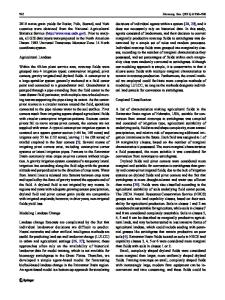Spatially Explicit Life Cycle Analysis of Cellulosic Ethanol Production Scenarios in Southwestern Michigan
- PDF / 5,305,158 Bytes
- 13 Pages / 595.276 x 790.866 pts Page_size
- 98 Downloads / 330 Views
Spatially Explicit Life Cycle Analysis of Cellulosic Ethanol Production Scenarios in Southwestern Michigan Keith R. Cronin 1 & Troy M. Runge 1,2 & Xuesong Zhang 3,4 & R. César Izaurralde 3,4 & Douglas J. Reinemann 2 & Julie C. Sinistore 5
# The Author(s) 2016. This article is published with open access at Springerlink.com
Abstract Modeling the life cycle of fuel pathways for cellulosic ethanol (CE) can help identify logistical barriers and anticipated impacts for the emerging commercial CE industry. Such models contain high amounts of variability, primarily due to the varying nature of agricultural production but also because of limitations in the availability of data at the local scale, resulting in the typical practice of using average values. In this study, 12 spatially explicit, cradle-to-refinery gate CE pathways were developed that vary by feedstock (corn stover, switchgrass, and Miscanthus), nitrogen application rate (higher, lower), pretreatment method (ammonia fiber expansion [AFEX], dilute acid), and co-product treatment method (mass allocation, sub-division), in which feedstock production was modeled at the watershed scale over a nine-county area in Southwestern Michigan. When comparing feedstocks, the model showed that corn stover yielded higher global warming potential (GWP), acidification potential (AP), and Electronic supplementary material The online version of this article (doi:10.1007/s12155-016-9774-7) contains supplementary material, which is available to authorized users. * Troy M. Runge [email protected]
1
DOE Great Lakes Bioenergy Research Center, University of Wisconsin-Madison, Madison, WI, USA
2
Biological Systems Engineering Department, University of Wisconsin-Madison, Madison, WI, USA
3
DOE Great Lakes Bioenergy Research Center, University of Maryland-College Park, College Park, MD, USA
4
Joint Global Change Research Institute of Pacific Northwest National Laboratory and the University of Maryland-College Park, College Park, MD, USA
5
WSP | Parsons Brinckerhoff, New York, NY, USA
eutrophication potential (EP) than the perennial feedstocks of switchgrass and Miscanthus, on an average per area basis. Full life cycle results per MJ of produced ethanol demonstrated more mixed results, with corn stover-derived CE scenarios that use sub-division as a co-product treatment method yielding similarly favorable outcomes as switchgrass- and Miscanthus-derived CE scenarios. Variability was found to be greater between feedstocks than watersheds. Additionally, scenarios using dilute acid pretreatment had more favorable results than those using AFEX pretreatment. Keywords Life cycle analysis . Energy crops . Spatially explicit . Eutrophication potential . Global warming potential . Bioenergy
Introduction The life cycle production of second-generation cellulosic ethanol (CE) and its environmental impacts are less studied and more uncertain than that of first-generation corn grain ethanol. Developing and testing potential scenarios for CE fuel pathways is one method for investigating this unce
Data Loading...










